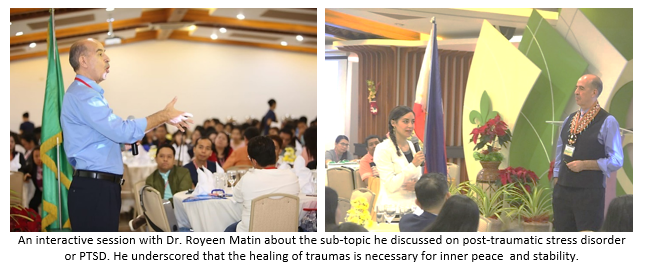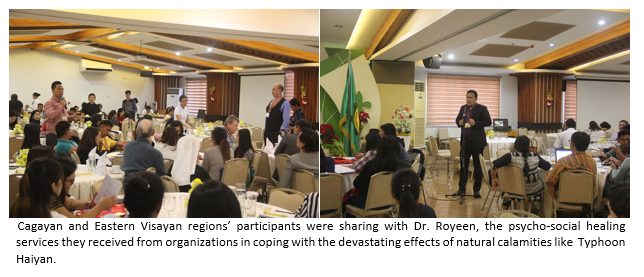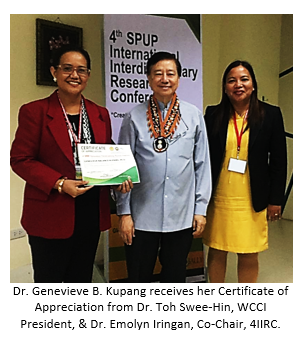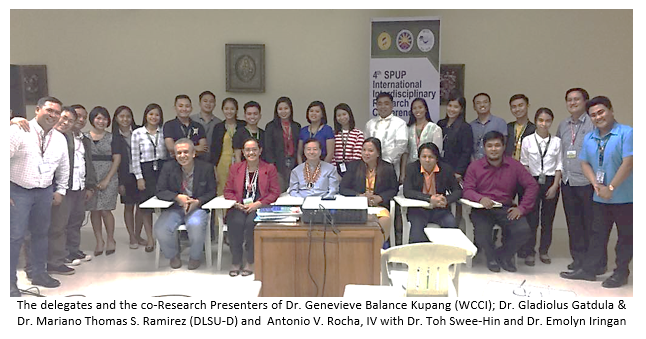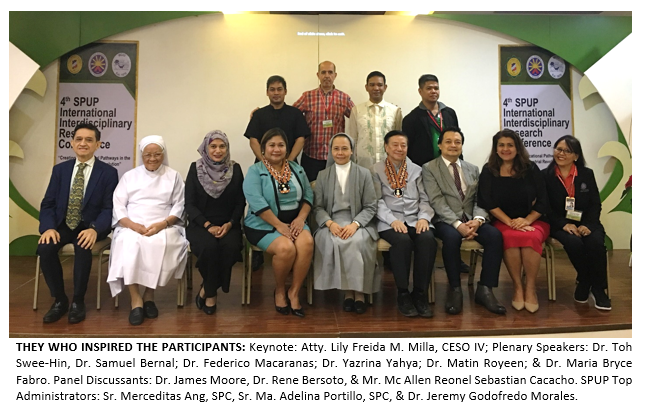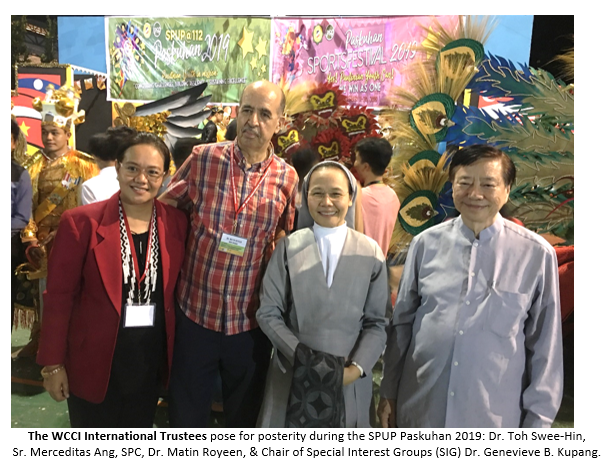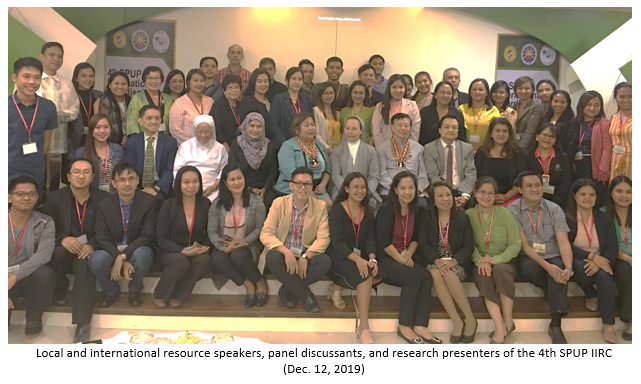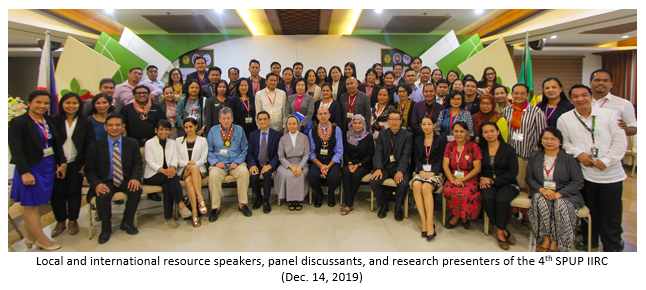Navigating the Fourth Industrial Revolution (FIRe), the World Council for Curriculum and Instruction (WCCI) trustees and delegates contributed significantly to the success of the 4th SPUP International Interdisciplinary Research Conference (IIRC) held at the Global Center of St. Paul University Philippines (SPUP), Tuguegarao City on December 12-14, 2019. The conference was a collaboration of SPUP, the Commission of Higher Education of the Republic of the Philippines, and WCCI..
Sr. Merceditas Ang, SPC, the WCCI international trustee and Philippine chapter president warmly welcomed the local and international resource speakers, panel discussants, research presenters, policymakers, health care professionals, educators, and administrators of local government agencies. She congratulated the research enthusiasts, innovators, and creative minds coming from near and far for their eagerness to share best practices, research findings and new discoveries which she believes would enhance the educational systems, improve socio-economic structures, and the holistic wellbeing of the members of society.
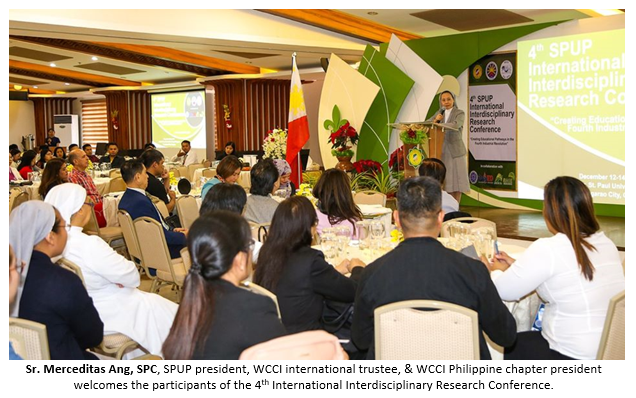
Oriented on the theme, “Creating Educational Pathways in the Fourth Industrial Revolution,” the WCCI international president Dr. Toh Swee-Hin rendered his input on “Nurturing Global Citizenship: Transcending Industrial Revolutions toward a Spiritual Revolution for Humanity and Mother Earth.” Swee-Hin posited that stakeholders need to ascend to our highest best self, our highest consciousness where we walk, think, speak, and act for the greater good of both humanity and the planet earth. To transcend the perplexing impact of the fourth industrial revolution (FIRe), stakeholders must consciously reflect and act responsibly towards the cultivation of “engaged spirituality,” a revolution towards a more humane, just, and compassionate living in consideration of the other beings in the universe known as “interbeing.” He reminded us that “spiritual growth cannot be a self-centered goal and process. It cannot be divorced from social and political action, but rather must help build alternative relationships, structures, systems that yield conditions for all people to cultivate spiritual growth while simultaneously fulfilling their basic rights, dignities and freedom.”
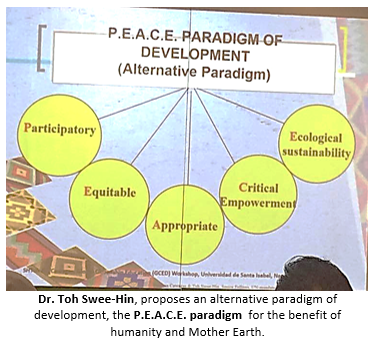
To counter the paradigm of development globalization from above/corporate-led globalization, Swee-Hin proposed an alternative globalization paradigm from below dubbed the P.E.A.C.E. Paradigm of Development-P for participatory; E for equitable; A for Appropriate; C for Critical Empowerment, and E for Ecological sustainability. The alternative paradigm counter the lack of food security, jobs, and other basic needs, unsustainable/inappropriate technologies, ecological destruction and commodification of the global commons, misuse of resources like warfare expenditure, and wasteful spending, economic disparities between rich and poor, cultural homogenization, discrimination against women, indigenous peoples and children, despair and fatalism.
The full-scale realization and the manifestation of our spirituality, that is, the nurturing, healthy, and authentic relationship with the self, others (seeing the other as sibling), Mother Earth, and the Divine for the believers of a Higher Force, is one important aspect of our being which is crucial to be cultivated fully if humanity and the planet earth is to survive and continue to sustainably thrive. Time-tested practices like rituals, retreats, prayer, nature walks, meditation, contemplation, and other spiritual practices are beneficial to achieving tranquility, serenity, and inner peace. He expressed there had been pitches and calls from past and contemporary spiritual personalities, gurus and peace advocates like Martin Luther King, Jr., Nelson Mandala, Archbishop Romero, Thomas Merton, Dorothy Day, Paulo Freire, Joanna Macy, Chris Johnstone, Thich Nat Han, Pope Francis, the Dalai Lama, among others. Based on his experience as a long-time peace educator, four pedagogical principles are crucial, namely: holism, values formation, dialogue, and critical empowerment. He cited the role of faiths and spiritual traditions in building a culture of peace. Concerning dialogue, special mention is the works being done by the “Parliament of World Religions,” “Religions for Peace,” in the global scale, and the grassroots exemplar of Silsilah Dialogue Movement in Mindanao, Philippines.
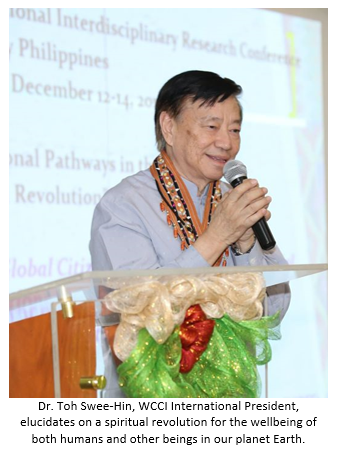
He also proposed alternative futures to resolve past and current problems and challenges without sacrificing the well-being of future generations. He emphasized the need to critically understand how and why conflicts occur, how we resolve them, undertaken in a creative and peaceful manner. He also shared the need to upscale our efforts and commitment to care for the earth as everybody now realizes the effect and impact of climate change.
Swee-Hin further posited that there is a need to cultivate considerable comprehension of the negative and positive consequences of “globalization.” To be worthy and effective citizens, a good grasp of the interrelatedness of international events can have direct and indirect effects on domestic affairs, hence the need for global citizenship education to transcend the fourth industrial revolution towards a spiritual revolution. Swee-Hin said, “for a time, human beings have seriously undermined the ability of planet earth to sustain itself.” Thus, he also stressed the need to dynamically deepen and cultivate the values of compassion, hope, justice, and love, not only for humanity but for other creatures as well. The commitment to human rights, dismantling of the culture of war and building cultural respect, reconciliation, and solidarity are also essential dimensions in building a culture of peace.
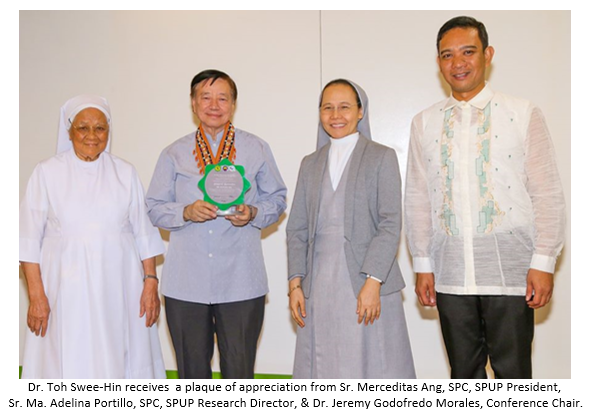
Dr. Matin Royeen, a WCCI international board member from the USA, was another valuable resource speaker who contributed to the success of the conference. He is a consultant at Rush University Medical Center, Chicago, and a Cross-Cultural Consultant. Royeen focused on “Peace Education and Intercultural Understanding in a Globalized Society.”
Dr. Royeen kicked off by sincerely dedicating his sharing to the memory of Dr. Tetsu Nakamura, a contemporary Japanese-Afghan hero, a great humanitarian aid worker, who was attacked and killed by an armed group in Jalalabad, Afghanistan on December 4 this year. Dr. Nakamura according to Royeen was a Japanese medical doctor, who, for decades, devoted his life to helping the Afghan people. He was loved by all Afghans and called him “Uncle Murad,” adopting him as an honorary Afghan citizen in October 2019. Royeen told the participants that Dr. Nakamura is one of a kind, and a true example in international understanding, having treated the Afghan people as his own, constructing a hospital, clinics and treating their illnesses, helping them in their livelihood by providing them irrigation systems, helping them build their sacred place of worship (mosque), Madrasa school, training center, sugar and cottage cheese industry, among others. Dr. Nakamura is one who showed that love, kindness, and generosity knows no boundaries. Dr. Nakamura’s patience and relentless determination have become “a sacrificial building block for symbiosis and harmony, transcending any established positions and prejudices,” one worthy of emulation in terms of intercultural understanding in a globalized society. Dr. Nakamura was a Ramon Magsaysay Awardee for peace and international understanding in 2003, an award often dubbed as the Nobel Prize in Asia (an addition from the writer).
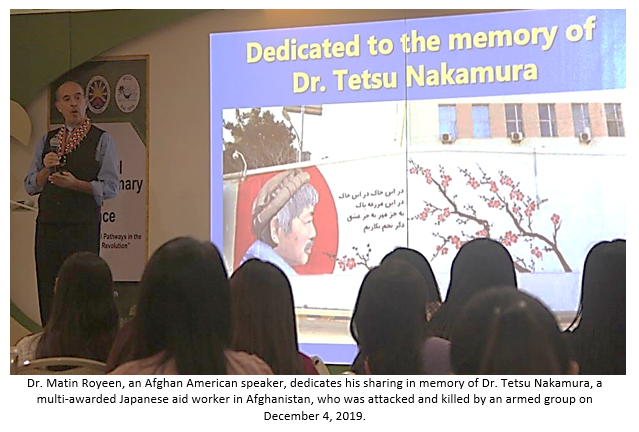
Royeen carried on with the brief historical overview, meaning and context of peace and peace education. Real-life stories, carefully selected case studies of peacebuilding efforts and songs brought home his message as he discussed the categories of peacekeeping, peace-making and peacebuilding towards intercultural understanding. In many peace fora, the usual examples given were the undertaking of men in peace education and advocacy, but worth noting was the speaker’s inclusion of the special contributions of women in peace like Jane Adams (1860-1935), Bertha Von Suttner (1843-1914), Maria Montessori (1870-1952), Birgit Brock-Utne (1985), Betty Reardon (1988), among others. Subsequently, an appreciation of the few models of peace education ensued - Burns and Aspeslagh (1996), Mary Montesorri, Reardon & Cabezudo (2002), and Toh and Cawagas (2004).
He discussed the macro or global threats to peace like climate change, pollution, illiteracy, nuclear energy, terrorism, and the malevolent application of advanced technologies. On the mezzo level, he mentioned of food deserts, homelessness, and military occupation. The conference participants during the interaction likewise mentioned large-scale destructive extractive industries, logging concessions, discriminations against indigenous peoples, land grabbing, and human rights abuses, causing internal displacements as part of the threats to mezzo or community peace. The later part was a discussion about post-traumatic stress disorder (PTSD), a threat to peace at the micro (individual) level. An individual suffering PTSD is a person without peace with possible impact on the community level and worldwide.
Royeen posed examples of threats to peace on micro, mezzo, and macro levels. Relating the experience in his native country in Afghanistan, he touched on the unimaginable devastation of war and conflicts. War is never a solution, he said! Ammunitions, tanks, and guns cannot solve the crucial problems of the world like poverty, hunger, inequality, drought, absence of health care, and quality education. He urged stakeholders, instead, to forge and collaborate with people of various backgrounds and find common ground and solutions to the problems of society. Like Dr. Nakamura, he believes in providing the basics in life like livelihood while upholding mutual respect among each other and the natural world, understanding differences, and diffusing shared values for the good of all.
Royeen shared a poem for the participants:
“In making war, we gain nothing but lose everything.
In making peace, we lose nothing but gain everything.
War obliterates our humanity and wounds our souls.
Peace reintegrates our dreams and rekindles the seeds of our hopes
Towards healing and feeling the unforgettable
Seeking to become a sane being in a safer world.” (Royeen, 2013).
He concluded by saying that peace and peace education call for the existence of a healthy society. In order to have a healthy society, we need to have healthy people. Health + Wellness + Balance = Peace, he said. The peace that is all-encompassing: peace of mind, gentle heart, and glowing spirit.
